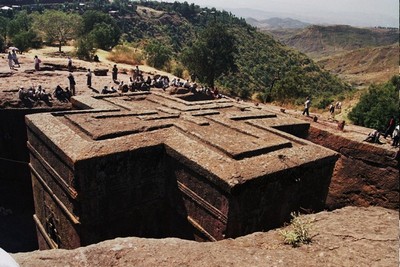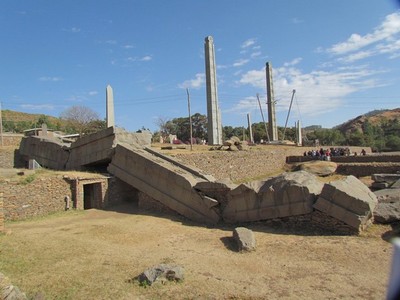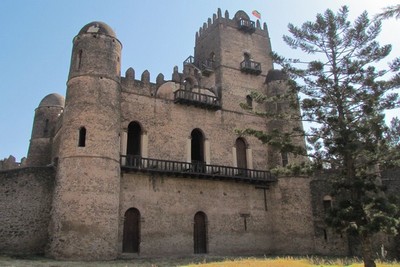Home > Africa > Ethiopia > 7-Days Ethiopia Historic Route Tour

7-Days Ethiopia Historic Route Tour
Tourcode SET0982
ADDIS ABABA
The name of this sprawling capital city means "New Flower". Founded by Emperor Menelik II in 1887 and situated at between 2300-2500 meters, Addis Ababa is the third highest capital in the world. Today it's one of African largest cities with a population of about 2 million and the continent's premier diplomatic center as the headquarters for African Union located here. Impressive monuments of colonial architecture are scattered among stretches of sun-bleached shacks. Addis Ababa, besides its many attractive sites, lies at the centre of an area rich in places of interest, most of which can be visited either as a half or full day trips.
BAHIR DAR
Ethiopia is a associated first and foremost with desert and drought - not a little ironic, when you consider that the fertile Nile basin, on which Egypt depends, receive 90% of its water from the Ethiopian highlands particularly this Blue Nile River, Bahir Dar, set at an altitude of 1830m, is a comfortale base for excursion by land and water to the Blue Nile waterfalls and a number of historic lake-side chruches and monasteries. Blue Nile Falls locally known as 'Tis Isat" (the water that smokes), about 30km after it exits Lake Tana, plunges over a 45 meter high rock face to fomr one of Africa's most spectacular waterfalls. Lake Tana, with the surface area of 3,673 sq km, is the largest lake in Ethiopia. Besides being the source of the Blue Nile, Lake Tana is renowned for its varied birdlife as well as housing on its islands and peninsulas more than 20 monastic churches most of which were founded in or before the 15th century, and are still in service today.
GONDAR
The next stop on the historic route, with its strategic hilltop location at an altitiude of 2,200 m in the Southern foothills of the Simien Mountains, is the graceful city of Gondar, site of numerous castle-like palaces, dating back from the seventeenth and eighteenth centuries.
The city was founded by Emperor Fasilidas in the 17th century and remained the capital of Ethiopia for the next two centures. It's known for its many medieval castles and the design and decoration for its churches. Among the dozen iedifices found on the precinct of the royal compound the earliest of the castles was created by Fasilidas himself and is still in such an excellent state of repain that it is stilll possible climb its stairs all the way to the roof which commands a breathtaking view over much of the city.
LALIBELA
Perched at an altitude of 2630m, among wild craggy mountains and vast rocky escarpments, Lalibela is a strikingly singular town famed for its 12th century rock-hewn churches. No matter if you've visited other rock-hewn churches in the rest of the world; nothing will prepare you for these.
At the end of the 12th and beginning of the 13th centuries, King Lalibela of the Zaghwe dynasty built a series of rock hewn churches, carved into the rugged mountainsides. There are 11 churches in the town named after him, with others in the surrounding countryside.
AXUM
The northern Ethiopia ancient city of Axum, regarded as the cradle of Ethiopian culture and Christianity, is the country's oldest extant urban settlement. From around 200 BC to 700 AD, Axum was the seat of an empire that extended across the Red Sea to Arabia, traded with India and China, had its own alphabet, constructed great engineering works and which, in the 4th century, was one of the four great powers of the world.
| Day 01 | Arrival Addis Ababa |
Morning arrival in Addis Ababa, you will be met and transferred to hotel.
Overnight at hotel in Addis Ababa
| Day 02 | Addis Ababa/Bahirdar by air |
In the morning, take a boat trip on Lake Tana and visit the old island monasteries of Ura Kidane-Mihret, and Kebran Gabriel (closed for women). Most of the monasteries decorated with frescoes and staffed with religious as well as historical treasures. There are 37 islands scattered about on the 3,000 square kilometer lake which is the source of the Blue Nile. About 20 of these islands house the churches and monasteries that are of immense historical and cultural interest. On the lake, be sure to notice the Tankwa boat, little papyrus boats that appear so flimsy yet are capable of carrying passengers and their good around the lake as they have done for many centuries.
Afternoon drive 70km round trip to visit Tississat named after the water falls of the Blue NileRiver (the life blood for the Sudanese and Egyptians). Be informed that clients will walk about 30 minutes to arrive near to the water falls on Blue Nile. So they are expected to wear appropriate clothes that match with hot weather and good shoes. Back to Bahirdar.
Overnight at hotel in Bahirdar
| Day 03 | Drive to Gonder |
Morning drive to Gondar visiting the Guzara castle, the beautiful landscape and transfer to hotel. Then after lunch you will be taken to visit the castle compound where you can see the medieval castle of King Fasilidas, King Yohannes, King Eyasu, King Dawit, King Bakafa and Queen Mentewab further visit of the churches of Debre Birhan Selassie with awesome wall paintings and the bath of King Fasilidas.
Overnight at hotel in Gonder.
| Day 04 | Gonder/Lalibela by air |
Take a morning flight to Lalibela, the world heritage city. After 40 minutes flight, you will arrive at Shimshaha (Lalibela Airport), transfer to hotel and start to visit the 1st group churches which are included Bieta Medhanialem (Chapel of Holy Savior) which is the biggest and Bieta Mariam (Chapel of Mary): three aisled with mural paintings and a covered pillar containing inscriptions about the end of the world according to the gadl (act) of saintly king. Further visit of Bieta Denagel (Chapel of the Virgins), Bieta Meskel (Chapel of the cross) and finally, the "double - church" of Debre Sina and Bieta Golghotha (women are not allowed in the latter since it's where the remains of King Lalibela are and also because it contains the tabernacle of the Holy Trinity).
Afternoon visit of the second group of rock-hewn churches that are namely: Bieta Gabriel and Raphael, Bieta Merquorios, Bieta Emmanuel with unprecedented Axumite style and the Bieta Abaa Libanos (said to have been built by King lalibela's consort Meskal Kebra and visit the Bieta Ghiorghis which is the cruciform chapel of St. George.
Overnight at hotel in Lalibela.
| Day 05 | The Lalibela HUDAD |
Today we will have different experience to Lalibela Hudad, surrounding the sacred Ethiopian town of Lalibela is a mountainous territory steeped in an ancient and biblical culture, where traces of a millenary mythology still mark the territory, and social practices are as alive today as they were 2,000 years ago. We use mule for trekking and it takes about 3 hours.
The Hudad, or "the Big Farm" was named this way by the king Lalibela - the builder of Lalibela's famed churches when he first travelled towards the town in the 11th century. He chose to join the local communities and to farm the land and tied his mule to a stone on the Hudad which is still visible today. The plateau, a secluded, ten hectare natural balcony, is now no longer herded and is in many ways a island, teaming with wildlife, and a precious and vibrant example of the montane grassland ecology. Here, as far as anyone can remember, lonely cattle herders have sat and idly gazed across the valley beyond, enjoying the mild and idyllic climate of their homeland. The Hudad is an ideal resting place for weary travelers, made private surrounding cliff faces and by a single entry point.
Around the Lalibela Hudad you will be able to view some of this interesting wildlife, most obviously the Gelada baboons (Theropitecus gelada). The animals are easy to recognize, they have thick brown fur and a distinctive hourglass shaped red patch of skin on their chest. Rare visitors to the area are the Hamadryas baboons (Papio hamadryas), these differ from the larger geladas in their coloring. The area is also rich in rock hyraxes. Then we will have lunch in the Eco Lodge, play foot ball and take rest in the beautiful grassland ground. Then late afternoon descend back to Lalibela.
Overnight at hotel in Lalibela Hudad.
| Day 06 | Lalibela Hudad/Axum by air |
Early morning flight to Axum. The most striking relics here are the giant obelisks that are believed to be thousands of years old. They are carved from single blocks of granite and the tallest was more than 100 feet high. Axum is also the centre for Ethiopia's Orthodox Christians. Ethiopia is one of the oldest Christian countries in the world, and you visit the remains of a chruch dating from the fourth century. Nearby is a 16th century church where the crowns of the Ethiopian emperors are stored. The Ark of the Covenant is reputed to be here, and some of the ruins are associated with the Queen of Sheba. There's plenty of time to see these fascinating sights, and you'll have a local guide to show you around.
Overnight at hotel in Axum.
| Day 07 | Axum/Addis Ababa by air |
Moving after breakfast departs to airport for flight back to Addis Ababa and start Addis Ababa city tour including Selassie Trinity Cathedral which is the resting place of the people who support Koreans, a drive to Mount Entoto for panoramic view of the city, national Museum which is the resting place of our ancestor LUCY, Ethnological museum to see the different tribes culture, Merkato the biggest open Market in Africa, souvenir shopping. Then attend farewell dinner in the famous Ethiopian traditional restaurant at Habesha 2000 with live music and delicious meal, you will be transferrd to Bole International airport for evening flight departure.
Have a nice holidays!
Remarks :
Every effort will be made to adhere to the planned itinerary. However, due to weather conditions and reasons beyond our control, changes to the itinerary might occur, for which the company accepts no responsibility.
|
|---|
Newsletter Subscription: 訂閱最新旅遊資訊
Site Map · Privacy Policy 私隱政策(只附英文版)
© 2020 Exotic-Holidays.hk · All Rights Reserved.
![]()

